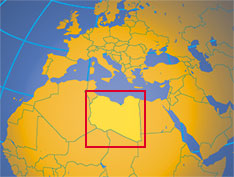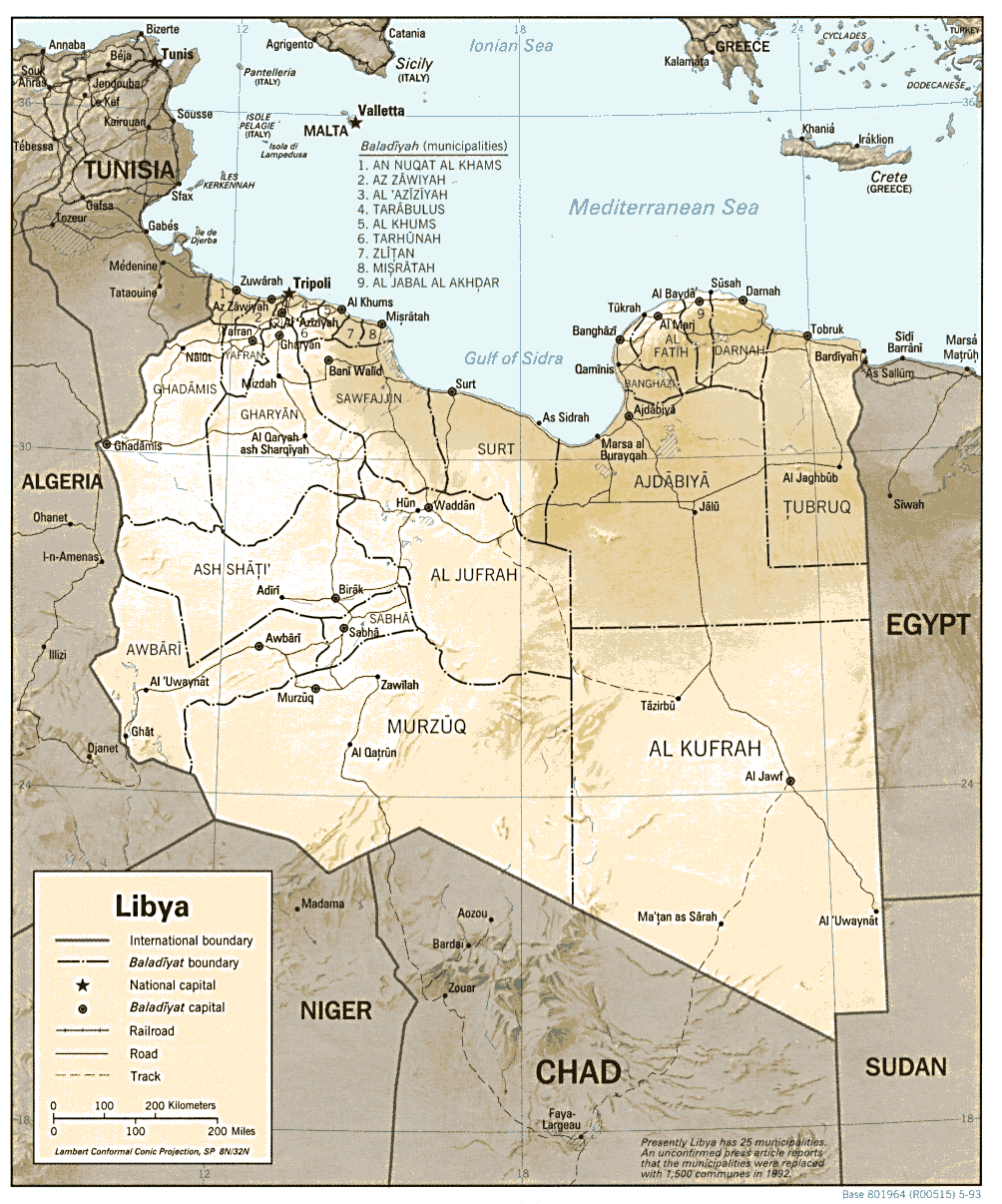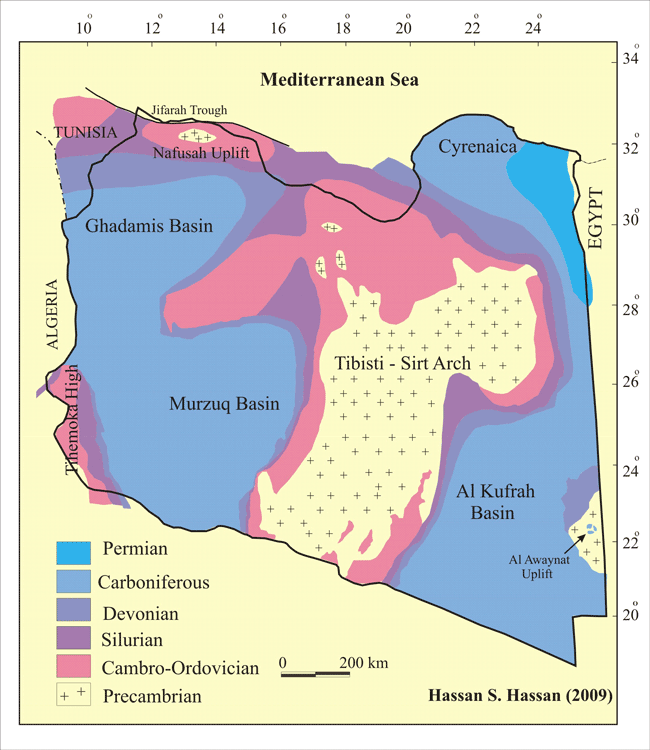Libya
 Geological
Research and Mining Department
Geological
Research and Mining Department
Industrial
Research Center
P.O. Box 3633, Tripoli
Phone: +218-21-691512
Fax: +218-21-691510
P.O. Box 3633, Tripoli
Phone: +218-21-691512
Fax: +218-21-691510
CIA Factbook
Political rights and civil liberties (Freedom House)
Arabic-English online dictionary
Travel and accommodation
The contribution of mining to total exports in 2010 amounted to 1.0%
Libya Mining News
Source: CIA Factbook
Geology
Geologically Libya belongs entirely to the Saharan domain forming the northern section of the African Shield. Apart from a few Precambrian outcrops, comprising schist, gneiss and foliated granitoids, the country is mostly covered by Palaeozoic, Mesozoic and Cenozoic, dominantly marine, sediments with locally developed areas of rift-related Neogene volcanics in the central part of the country.
Mining
In terms of non-fuel commodities, Libya was Africa’s third largest producer of pig iron and steel accounting for an estimated 12.7% and 6.6% respectively of total production. Output of both these commodities decreased by 5.5 and 9.0% respectively in 2008 and dropped further during the recession in the first half of 2009. Expansion of steel capacity to 4 Mt /yr will be completed by 2012. All the iron ore and ferroalloy feedstock is currently imported. Libya is also a significant producer of gypsum (ranked 5th) and salt in Africa.
Oil & Gas
Libya was the world’s 18th largest producer of crude oil (1.9%) and with 5.955 Gt of proven reserves is globally in ninth position (3.6% equivalent). It was ranked third amongst African oil-producing countries after Nigeria and Angola accounting for 17.6% of total output. Libya was the fourth largest natural gas producer in Africa accounting for 7.6 per cent of total output. Natural gas production increased by 4.06 per cent in 2008, and as of the beginning of 2009 proven reserves stood at 1.54 trillion m3. The National Oil Company has set a goal of nearly doubling annual production of natural gas to 31 billion m3 by 2010 and crude oil to 149.6 Mt / yr by 2012. About 80 percent of Libya’s proven oil reserves are located in the Sirte basin, which is responsible for 90 percent of the country’s oil output. Libya remains "highly unexplored" according to reports by Wood Mackenzie, and only around 25 percent of Libya is covered by exploration agreements with oil companies
Maps and images
- Libya Cities,Towns, Airports, Maps, Images
- Libya Geomorphological map
- Libya Image-1
- Libya Image-2
- Libya Minerals
- LibyaMaps.com: sell digital maps for use in illustrating reports, presentations, articles, newsletters and websites. At present two publications are available on CD or for download:
1) a general maps, images and resource disk.
2)a disk of petroleum maps, images, and informational resources which is primarily composed of USGS maps and reports.
Companies active in oil & gas exploration in Libya:
- NOC: National Oil Corporation of Libya.
- Sahra Oil Consultance (Oil and Gas consultancy for companies planning to do business in Libya)
- Bula.
- Energy Africa.
- OMV.
- Repsol.
- VEBA.
- Wintershall.
- Umm Al-Jawaby Oil Service Company.
- Libyan contacts for the oil and gas industry.
- Agip (ENI).
- Petronas.
- KCA Drilling.
- Robertson Research (new ventures).
- Equipoise(database assimilation).
- Getech (basin analysis).
- Petroleum law and policy (Dundee University).
- Consultancy for companies interested in Libya.
- Business risk analysis and consultancy.
- Oil and gas activities, incl. petroleum news (MBendi): Introduction, Exploration.
- Overview hydrocarbons and mining in Libya.
- Directory of Libyan oil companies provided by libyaninvestment.com.
Libya relies on oil and natural gas to satisfy energy consumption demand. Economic growth in Libya is dependent on the hydrocarbon industry. According to the World Bank, the country’s hydrocarbon exports account for over 95 percent of total merchandize exports and revenues from the oil and natural gas sectors amount to over half of the country’s gross domestic product (GDP). Since the United Nations and the United States lifted sanctions over Libya in 2003 and 2004, respectively, oil majors have stepped up exploration efforts for oil and natural gas in the country. Likewise, companies have tried using enhanced oil recovery (EOR) techniques to increase production at maturing fields. Over the next six years, Libya would like to see oil production capacity increase by 40 percent from 1.8 million barrels per day (bbl/d) to 3 million bbl/d by 2013.
Libya, a member of the Organization of Petroleum Exporting Countries (OPEC), holds the largest proven oil reserves in Africa, followed by Nigeria and Algeria. According to Oil and Gas Journal (OGJ), Libya had total proven oil reserves of 41.5 billion barrels as of January 2007, up from 39.1 billion barrels in 2006. About 80 percent of Libya’s proven oil reserves are located in the Sirte basin, which is responsible for 90 percent of the country’s oil output. Libya remains "highly unexplored" according to reports by Wood Mackenzie, and only around 25 percent of Libya is covered by exploration agreements with oil companies. The under-exploration of Libya reflects the impact of former sanctions and also stringent fiscal terms imposed by Libya on foreign oil companies.
- Oil production: 1.72 million bbl/day (2006 est.)
- Oil exports: 1.34 million bbl/day (2004)
- Oil proved reserves: 42 billion bbl (2006 est.)
- Natural gas production: 8.06 billion cu m (2004 est.)
- Natural gas exports: 2.13 billion cu m (2004 est.)
- Natural gas proved reserves: 1.472 trillion cu m (1 January 2005 est.)
- According to the International Crude Oil Market Handbook, Libya’s National Oil Corporation (NOC) would like to raise oil production from 1.80 million bbl/d in 2006 to 2 million bbl/d by 2008 and to 3 million bbl/d by 2010-2013. In large part, NOC’s production goals depend on its ability to finance its share of development costs. Future foreign investment into the oil sector is likely, especially with the improved investment climate that stems from the United Nations and United States lifting sanctions. Previously, sanctions had caused delays in a number of field development and EOR projects and had deterred foreign capital investment. Overall, Libya is considered a highly attractive oil province due to its low cost of oil recovery (as low as $1 per barrel at some fields), the high quality of its oil, and its proximity to European markets.With state-operated oil fields undergoing a 7-8 percent natural decline rate, Libya's challenge is maintaining production at mature fields, while finding new oil and developing new discoveries.
- In November 2005, Repsol YPF (operator) announced that it had discovered a significant new oil deposit of light, sweet crude that extends over two licenses in the Murzuq Basin. Industry experts believe the discovery to be one of the biggest made in Libya for several years. The discovery is partly located in license NC-186, which currently produces around 60,000 bbl/d. Production on the license is expected to increase over the next 4-year period (2007-2011) by 100,000 – 150,000 bbl/d as oil from the discovery comes online. Repsol YPF is joined by a consortium of partners that includes OMV Aktiengesellschaft, Total and Norsk Hydro.
- Also located in Murzuq Basin is Eni’s Elephant field. In October 1997, an international consortium led by British company Lasmo plc, along with Eni and a group of five South Korean companies, announced that it had discovered large recoverable crude reserves (around 700 million barrels) at the NC-174 Block, 465 miles south of Tripoli. Lasmo, which was purchased by Eni in 2001, estimated that production from the field would cost around $1 per barrel. Elephant began production in February 2004 at around 10,000 bbl/d. In 2006, Eni indicated that Elephant was producing at around 125,000 bbl/d, and the company was hoping to see the field reach full capacity of 150,000 bbl/d by 2008.
- Waha Oil Company’s (WOC) Waha fields currently produce around 350,000 bbl/d, down from around 1 million bbl/d in 1969 and 400,000 bbl/d in 1986. However, WOC expects to increase Waha output by around 200,000 bbl/d over the next couple of years.
- In 2005, ConocoPhillips and co-venturers reached an agreement with NOC to both return to its operations in Libya and to extend the Waha concession by 25 years. ConocoPhillips operates the Waha fields with a 16.33 percent share in the project. NOC has the largest share of the Waha concession 59.17 percent, and additional partners include Marathon (16.33 percent), and Amerada Hess (8.17 percent).
- BP plc [NYSE:BP] negotiated an agreement with Libya to explore for natural gas in the north African country, the chairman of the state owned National Oil Corporation announced in May, 2007.
- ExxonMobil [NYSE:XOM] obtained a licence in 2005 to explore an area covering 2.5 million acres in the Cyrenaica Basin, one of the country's largest energy fields.
References
Academic geological studies in Libya
- Petroleum Geology of Libya overview (by Hassan S. Hassan, Univ. of South Carolina)
- Training film series on DVD: Petroleum Geology of Southern Libya, by Sebastian Lüning et al. (2007)
- Crystalline basement and volcanic rocks of Libya, by Rajab Alkhazmi
- Abstracts of the Workshop Cretaceous-Tertiary Biostratigraphy of Cyrenaica (Bremen 2005)
- The Silurian petroleum source rock of Libya (by Sebastian Lüning & Markus Geiger)
- Palaeogeological maps (Stephanian-Autunian to Pliocene) of Libya and the Gulf of Sirte (IGCP 369).
- U.S. Geological Survey Bulletin 2202-A: Total Petroleum Systems of the Illizi Province, Algeria and Libya -- Tanezzuft-Illizi (by T.R. Klett).
- U.S. Geological Survey Bulletin 2202-C: Total Petroleum Systems of the Trias/Ghadames Province, Algeria, Tunisia, and Libya -- The Tanezzuft-Oued Mya, Tanezzuft-Melrhir, and Tanezzuft-Ghadames (by T.R. Klett).
- Modelling of Ypresian carbonate reservoirs from Libya (PhD thesis, JORRY Stephan,Stephan.Jorry@terre.unige.ch).
- Impactites from the Libyan Desert.
- A Guide to Macrofossils Localities in Libya (by Jacques LeBlanc).
- Palaeogeographic map Carboniferous-Pliocene Libya and Gulf of Sirte (IGCP 369).
- Radar images revealing inactive stream valleys in Wadi Kufra (SE Libya) by NASA (report, figures).
- Facies analysis of Early Tertiary carbonates in Northeast Libya (Hamed Omar Elwerfalli).
- Waw an Namus (volcano).
- Geological maps and books, Libya (ecocart).
- Report of the Cambridge expedition to Cyrenaica, 1959.
- U.S. Geological Survey Bulletin 2202-D: Total petroleum systems of the Pelagian Province, Tunisia, Libya, Italy and Malta - the Bou Dabbous - Tertiary and Jurassic-Cretaceous composite (by T.R. Klett).
- Offshore Sirte Hypothetical Assessment Unit 20430103 (USGS report).
- Central Sirte Carbonates Assessment Unit 20430102 (USGS report).
- Sarir Field, Sirte Basin, Libya: Search and Discovery article #10005 (2000). Compiled from articles by C.J. Lewis (1990) and R.M. Sanford (1970), with database of field parameters compiled by Jingyao Gong, AAPG Data Systems.
- Libya: Petroleum potential of the underexplored basin centers - a twenty-first-century challenge(Search and Discovery article #10025, 2002, by Donald C. Rusk).
- Petroleum generation and accumulation in the Berkine basin, eastern Algeria (N. Yahi, R.G. Schaefer & R. Littke). A pdf file of this paper (AAPG Bulletin vol. 85(8), August 2001) is available for download.
- IRC: Industrial Research Centre, Libya.
Commercial geological and petroleum studies
- FrOGTech Libya reports, focus on tectonostratigraphic framework
- Petroleum Reservoir Study of Libya (by Global Exploration Services)
- Evaluation of the petroleum potential of new licensing blocks Libya by Target Exploration. See also geothermal study about Hagfa Trough, Sirte Basin and (new release in 2001) 'Geology and basin analysis of western offshore Libya'.
- Libyan petroleum geology datasets in Geographic Information System (GIS) format are offered by LYNX Information Systems Ltd.
- Overview of Libyan Oil and Gas Industry by Mbendi Trade Services.
- Libya Seep Mapping, by NPA.
- Libya seep screening study and Eastern Mediterranean seep-seismic study, by Infoterra (formerly NRSC).
- Source implications of petroleum compositions: Sirte Basin. Study by Humble Geochemical Services and OilTracers L.L.C.
- Geology and Discovery of the Sarir Field, Sirte Basin.
- Murzuq Basin Study by Masera Corp.
- Gravity Depth-To-Basement Study (Getech).
- Consultancy Support Ltd.: Support for companies working in Libya.
- Mining in Libya (MBendi).
- Exploration data / reports offered by First Exchange.
- Teknica Overseas Ltd. Consulting services and software products in geoscience disciplines including geology, geophysics, engineering and database technology.
- Geology of the Sirte Basin (summary of a document from Northern Light's Special Collection).
- Oil and gas opportunities in Libya (book review by CWC Group).
- Don Hallett: consultant petroleum geologist specialising in Libya and North Africa.
- Malta: geological setting and hydrocarbon prospectivity of Block 7 Area 4.
- Ghadames Basin: a comprehensive, up-to-date study of the geology, hydrocarbon habitat and future exploration potential of the Ghadames Basin of western Libya, eastern Algeria and southern Tunisia. A report by ECL in conjunction with Adil Jawzi and Associates. Study outline and report contents available to download.
Books on the geology of Libya:
- Overview compiled by 'Libya resources on the internet'.




